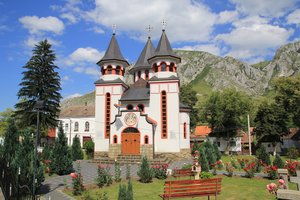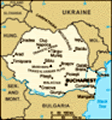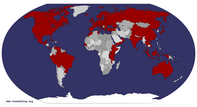Advertisement
Published: August 25th 2015

 Rimetea
Rimetea
The church in the village RimeteaChurches and monasteries
This year we decided to make Romania the destination of choice for our summer vacation. When we told family and friends that we were going to the country of Vlad Dracul we mostly got the reply "But why?" accompanied with a somewhat puzzled look like we had gone insane or something. When we then answered "Well, why not?" nobody could give a reason why not. Now that we have spent three weeks visiting interesting places in many corners of Romania all we can say is "Why don't everybody go to Romania?" because we had an absolutely great time there.
Well, not everybody thought Romania was a strange country to visit. Ake's colleague said "Wow, you are going to Romania! How cool!". But Ake's colleague was born in Romania so perhaps she is biased...
There are many reasons why we had such a great time on our vacation and we can't mention them all. But to make it short we can just say that it is a civilised country with good and easily accessible coffee, good food and with plenty of interesting sightseeing and such places are always great to

 Sibiel
Sibiel
This little roadside shrine we saw in central Sibielvisit if you ask us. We can actually only think of one thing that we didn't like there: Romanians drive cars like crazy.
We spent a total of three weeks in Romania and this the first blog entry from this jouney will be focused on sacred buildings. This blog entry is all about churches and monasteries. If you think that sounds interesting read it, if it sounds boring don't.
Religion is important in Romania. Even very small villages often have two or three churches and there are hundreds of monasteries in the country. Many of these churches and monasteries are well worth a visit. Even if you single out only the most important churches you are going to end up seeing quite a few. We knew already before we started the journey that we have to limit the number of churches we go to because otherwise we are sure to get "churched out", that is we would get bored and all sick of churches.
The first church pictured on this blog is in a village called either
Rimetea or Torocko depending on if you use the Romanian or the Hungarian name.

 Curtea de Arges
Curtea de Arges
St Nicholas Church in Curtea de Arges. It sits next to the ruins of, and was once part of, the princely court from the 14th. The village is in a region where a large percentage of the population is ethnic Hungarian and speak Hungarian as their first language. It is a very beautiful church in a very pretty village. We will write a little bit more about the village in a future blog entry.
In a small village called Sibiel there is a museum called Museum of Glass Icons. This museum is based on a collection of a special kind of religious paintings on glass, so called glass icons, put together by a local priest. These glass icons were common in private homes and were an important part of the private religious ceremonies. The pictures painted were often naïve and simple. We took a bit of a chance when we went to this museum. Fortunately we enjoyed it and we found it worth the little detour we had to make to get there.
St Nicholas Church in Curtea de Arges. It sits next to the ruins of, and was once part of, the princely court from the 14th. The church is roughly 700 years old and has been carefully renovated. The exterior of the church is splendid but there

 Curtea de Arges
Curtea de Arges
The exterior of the church is splendid but even better is the frescoes inside it. is somethinhg that is even better - the frescoes inside it. When we visited St Nicholas Church there was a concert in there so we could only view the frescoes from a distance. But the concert was pretty good so you might say although we were unlucky not to be able to fully enjoy the frescoes we were still lucky to get to listen to a good concert. We have added a small video clip from the concert. The quality is a bit poor but at least you get an idea of what it was like.
A somewhat unusual place to find a sacred place was in
Salina Turda, a former salt mine. When they were mining salt in Turda they built a small shrine possibly because they thought it would help them avoid accidents. Today the mine is a museum, we will write a little more about that in a future blog entry, and the shrine is part of that museum.
In 1993 UNESCO added
seven villages in Transylvania to the world heritage list recognising the value of the unique fortified churches in these villages. During a period of 400 years, from the 13th

 Museum of Glass Icons in Sibiel
Museum of Glass Icons in Sibiel
This museum is based on collection of religious paintings on glass, so called glass icons, put together by a local priest.to the 16th century, Transylvania was an unsafe region. The people living there had to be prepared for war or other violent encounters. In the villages the most important building was the local church. What they did was that they built strong walls around the church so that the church could serve both as a place for worship and as a stronghold. The villagers could in time of unrest take refuge in the church and endure a lengthy siege there thanks to extensive storage facilities. In one of the fortified churches they could even relocate the school to one of the rooms in the fortress.
We visited two fortified churches in Transylvania. One was in the village Prejmer and the other was in the village Miercurea Sibiului. The one in Prejmer was one of the churches on the UNESCO list where as the one in Miercurea Sibiului was not. Visiting the church in Prejmer was easy. They have specified opening hours, staff manning the ticket booth and basically everything else you expect to find at a popular tourist attraction. Visiting the church in Miercurea Sibiului was more of a challenge. Since it is not one of the

 Salina Turda
Salina Turda
When they were mining salt in Turda Salt Mine they built a small shrine possibly because they thought it would help them avoid accidents. churches on the world heritage list it receives less attention from tourists. Or perhaps we should say it receives virtually no attention at all. We stopped there only because we saw a sign on the road saying that they have a fortified church. We found the church easily enough, it was right in the middle of the village so it was hard to miss, but getting inside the church was not as easy. We asked first at a café in town if they knew who to talk to. The girl managing the café had no idea. We then asked two ladies who were doing some gardening in the village centre if they could help us getting in contact with the person having the key to the church. First they seemed not to be able to help us. But apparently they talked to someone who in turn kept on spreading the news that two tourists were there with the intention of having a look at the church. Because a little while later a man showed up explaining that he could get us in. First we thought it was strange because he had no key. Instead he went up to the door

 Prejmer fortified church
Prejmer fortified church
During a period of 400 years, from the 13th to the 16th century, Transylvania was an unsafe region. They built strong walls around the church so that the church could serve both as a place for worship and as a stronghold. and started shouting something in Romanian. Very soon the door opened from the inside and we could enter the compounds.
If we understood things right the two men were father and son and the son rents a room there and uses the fortress section as home, storage and workshop. One of the advantages about taking an unscheduled tour, like the one we did in Miercurea Sibiului, is that if you manage to get in you can sometimes see things that would be in closed off sections if you visit on regular tours. Here for instance we were allowed to go up in the steeple. It was a slightly difficult climb up there but it when we reached the top we were rewarded with a great view over the village and we could take a look at what the world of Quasimodo would have been like if he had been the hunchback of Miercurea Sibiului fortified church instead of Notre Dame in Paris.
There are also other churches in Romania listed on the UNESCO world heritage list. The wooden churches of Maramures is one such example. The wooden churches were built during a time when

 Prejmer fortified church
Prejmer fortified church
The people could in time of unrest take refuge in the church and endure a lengthy siege there thanks to extensive storage facilities. In one of the fortified churches they could even relocate the school to one of the rooms in the fortress. local authorities didn't permit churches to be built from stone. We have no idea why such a regulation was in place but according to our sources it was like that. So the locals had to erect churches made from wood instead. Over the time they developed their building skills more and more and eventually the churches were attractive both from an architectural and artistic point of view. We ended up visiting quite a few of these wooden churches.
In the small village
Budesti they had two wooden churches and one of those were on the world heritage list.
Another one, also recognised by UNESCO for being an "outstanding example of vernacular religious wooden architecture", is the wooden church in
Poienile Izei. We went to that church mostly because we were interested in seeing the dramatic frescoes showing Hell and the sufferings awaiting people who end up there in afterlife.
We also saw one wooden church in the village Laschia and we saw one that used to be in the village Timiseni but is now in the
National Village Museum, an open-air museum in Bucharest.
On our travels we also visited two

 Miercurea Sibiului fortified church
Miercurea Sibiului fortified church
Visiting the church in Miercurea Sibiului was a bit of an adventure. Since it is not one of the churches on the world heritage list it receives very little attention from tourists.churches in the region Moldavia. These churches are special in the sense that they have extensive frescoes painted both on the inside and the outside. The two we visited were one in the village
Voronet and one in the village
Manastirea Humorului, slightly strange name for a village, both
world heritage sites. It's a pity we weren't allowed to take pictures inside the church in Voronet because those frescoes were fascinating. We believe the frescoes showed how various Christian martyr's lives ended. Needless to say the pictures were gruesome. They could actually form the bulk of an encyclopaedia over execution methods.
In the end we have thrown in one photo of the
Black Church in Brasov. It is called Black Church because the façade was blackened by a fire in 17th century.
As we mentioned above we knew that we could end up being churched-out if we saw too many churches and therefore adapted a strategy to avoid that. Our strategy worked because we didn't get tired of seeing churches. We have also taken on the strategy when we write these blog entries that we write about sacred buildings only in one of them, this one, to avoid

 Miercurea Sibiului fortified church
Miercurea Sibiului fortified church
One of the advantages about taking an unscheduled tour is that if you manage to get in you can sometimes see things that would be in closed off sections in other places. We were allowed to go up in the steeple. Here is what the world of Quasimodo would have been if he had been the hunchback of Miercurea Sibiului fortified church instead of Notre Dame in Paris.
readers getting tired of churches and stop following our blog. We hope this strategy worked and you enjoyed reading this. Next blog entry will not have a single church in it. It will be about something totally different but still contain stories from our journey in Romania.
Advertisement
Tot: 0.145s; Tpl: 0.016s; cc: 23; qc: 34; dbt: 0.0791s; 1; m:domysql w:travelblog (10.17.0.13); sld: 1;
; mem: 1.2mb





























Dancing Dave
David Hooper
Last supper
What a great idea to visit Romania...your pics are fantastic. I chose this photo for no other reason than to highlight the many ways the Last Supper is depicted in various cultures and always with a local flavour.